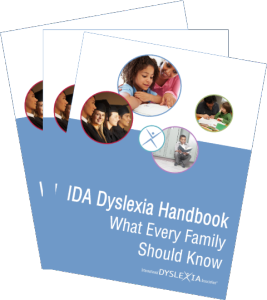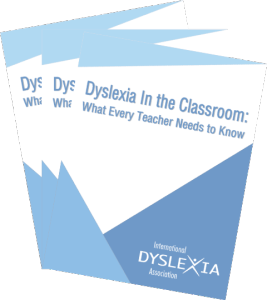IDA Dyslexia Handbook:
What Every Family Should Know
 IDA Dyslexia Handbook: What Every Family Should Know is a digital handbook that contains invaluable information like the characteristics of dyslexia, what it is and what it isn’t. This digital handbook also provides information on valid assessments, effective teaching approaches, self-advocacy ideas and a vast array of resources. Further, the handbook contains information that will be useful throughout a child’s life, from elementary school through college.
IDA Dyslexia Handbook: What Every Family Should Know is a digital handbook that contains invaluable information like the characteristics of dyslexia, what it is and what it isn’t. This digital handbook also provides information on valid assessments, effective teaching approaches, self-advocacy ideas and a vast array of resources. Further, the handbook contains information that will be useful throughout a child’s life, from elementary school through college.
The degree of difficulty a child with dyslexia has with reading, spelling, and/or speaking varies from person to person due to inherited differences in brain development, as well as the type of teaching the child receives. The brain is normal, often very “intelligent,” but with strengths in areas other than the language area. This “difference” goes undetected until a child finds difficulty when learning to read and write.
There are limited resources about dyslexia available to families. It is crucial to be able to recognize its signs and symptoms so that a child can be evaluated early and obtain the appropriate instruction and accommodations he or she needs to succeed in school.
We encourage you to share this handbook with as many people as possible. The more families we can inform, the more children we can help!
Dyslexia in the Classroom:
What Every Teacher Needs to Know
 Dyslexia in the Classroom: What Every Teacher Needs to Know, is a digital kit provided to every public elementary school in the United States. The kit helps to raise awareness, share best practices, and be a resource to the school’s administration and staff.
Dyslexia in the Classroom: What Every Teacher Needs to Know, is a digital kit provided to every public elementary school in the United States. The kit helps to raise awareness, share best practices, and be a resource to the school’s administration and staff.
Currently, there are limited resources available to public elementary school teachers related to dyslexia and other learning differences. IDA is opening the door to a better understanding of dyslexia by providing this vital resource to support teachers in their passion to help every child reach their fullest potential.
We encourage you to share this handbook with as many people as possible. The more educators we can inform, the more children we can help!
